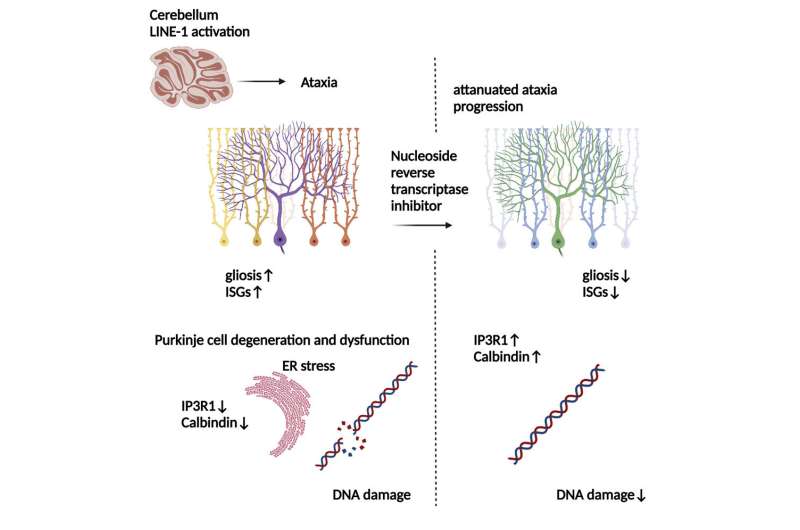'Jumping' genes yield new clues to origins of neurodegenerative disease

Massive, repetitive stretches of DNA in the human genome may harbor hints about the onset of a rare, inherited neurodegenerative disorder called ataxia-telangiectasia as well as other related diseases, a new Yale School of Medicine study finds.
The findings also point to possible directions for treatment of the disease.
The results are published Sept. 6 in the journal Neuron.
Almost half the human genome is comprised of transposable elements, long and short stretches of DNA called "jumping genes" for their ability to move from one location of the genome to others. Once called "junk" DNA, these transposable sequences have been shown to play crucial regulatory roles in many biological functions. Once they fulfill these myriad roles, molecular regulators usually silence their expression.
For the new study, the Yale team—which was led by Takehiro Takahashi, associate research scientist in the lab of Akiko Iwasaki, Sterling Professor of Immunobiology—explored the role of one the most common transposable elements, known as long interspersed nuclear element 1 (LINE-1), in neurodegenerative disease.
They found that activation of LINE-1 correlated with damage to the cerebellum in patients with ataxia-telangiectasia, which impairs coordination and causes deficits in immune and other body systems. LINE-1 elevation in the cerebellum of these patients was associated with significant neuroinflammation, they found. The median life expectancy of patients with the disorder is between 19 and 25 years of age.
In mouse models of the disorder, researchers found that the activation of LINE-1 was sufficient to cause cellular damage and death in the cerebellum of mice. However, when the mice were treated with reverse transcriptase inhibitors—such as the ones used in treatment of HIV —progression of the disorder was reduced.
The antiretroviral therapy may help suppress activation of LINE-1 in genetically prone individuals, which is silenced in most people after early development, the researchers say.
The findings are intriguing, researchers said, because several different labs are now exploring the role of LINE-1 in onset of neurodegenerative diseases such as schizophrenia, Amyotrophic lateral sclerosis (ALS), and Alzheimer's disease.
"There are assuredly multiple contributors to these disorders, but the role of LINE-1 offers researchers an exciting new line of inquiry," said Takahashi, who was lead author of the study.
Iwasaki and Tamas Horvath, the Jean and David W. Wallace Professor of Comparative Medicine at Yale and professor of neuroscience and of obstetrics, gynecology, and reproductive sciences, are co-corresponding authors.
More information: Takehiro Takahashi et al, LINE-1 activation in the cerebellum drives ataxia, Neuron (2022). DOI: 10.1016/j.neuron.2022.08.011





















